Which motorhome? Choosing the perfect motorhome for you
Choosing a motorhome or campervan is one of the biggest buying decisions you’ll ever make so let us guide you into making the right decision
Page contents
- Which motorhome is right for you?
- Campervan or motorhome
- Types of campervan
- Types of motorhome
- Choosing the right size of campervan
- The best campervans and motorhomes to buy
- About our magazines
Words by Peter Vaughan
Which motorhome is right for you?
There are hundreds of different motorhome types, styles, layouts and designs on the market, and it can be hard to know where to start when choosing a motorhome.
Ask yourself why you want to buy a motorhome. If you are a first-timer, how – and how often – will you use the vehicle? Where do you want to go in it?
Having a clear idea of the way you’ll use your intended purchase will make the choosing process easier.
If you’re already a motorhomer and looking to change, ask yourself why you’re upgrading. Do you want a bigger vehicle for more space, or a smaller or lighter one for easier driving (or driving licence reasons)?
Do a detailed assessment of your current motorhome and note the elements you like and dislike, then list the features you must have in your next motorhome.
Campervan or motorhome: what’s the difference?
A campervan (or camper) is essentially a van that has been converted from a commercial vehicle for a leisure role, with the addition of seats, windows, insulation, furniture, etc.
It may have a pop-top or a permanent high roof to give standing room – see the different types of campervan below.
There’s a huge variety of campervans built by the major British and European motorhome brands and even Ford, Mercedes and VW offer their own campervan models (the Nugget, Marco Polo and California range, respectively).
However, a large part of this fast-growing market is also made up of smaller companies who usually sell direct from their factory.
A motorhome – in the past usually called a motorcaravan – is often also described as a coachbuilt. This refers to the fact that, traditionally, coachbuilders added a caravan-style living area onto the back of a cab of a light commercial vehicle.
Nowadays most motorhomes come from large specialist manufacturers that are often part of big groups (Erwin Hymer, Knaus-Tabbert, Rapido, Trigano, etc), these firms often having a history of caravan construction behind them, as do big British brands, Bailey and Swift.
There are a number of advantages of motorhomes over campervans. For a start, the squarer body sides allow for better use of the interior space, while the sandwich construction of the bodywork makes it easier to provide full insulation for year-round use.
It’s also more cost-effective to build the habitation area of a motorhome onto the blank canvas of a chassis than it is to convert a panel van.
But, conversely, there are also advantages of campervans over motorhomes, as they are usually more compact (especially in width) and easier to drive.
They look more automotive, with a wide range of exterior colours, and they benefit from more car-like all-steel construction. Some will also prefer the feel of being closer to camping, with large sliding doors bringing the outside in.
For the different types of motorhome – low-profile, overcab and A-class – see below.
Types of campervan:
Pop-tops
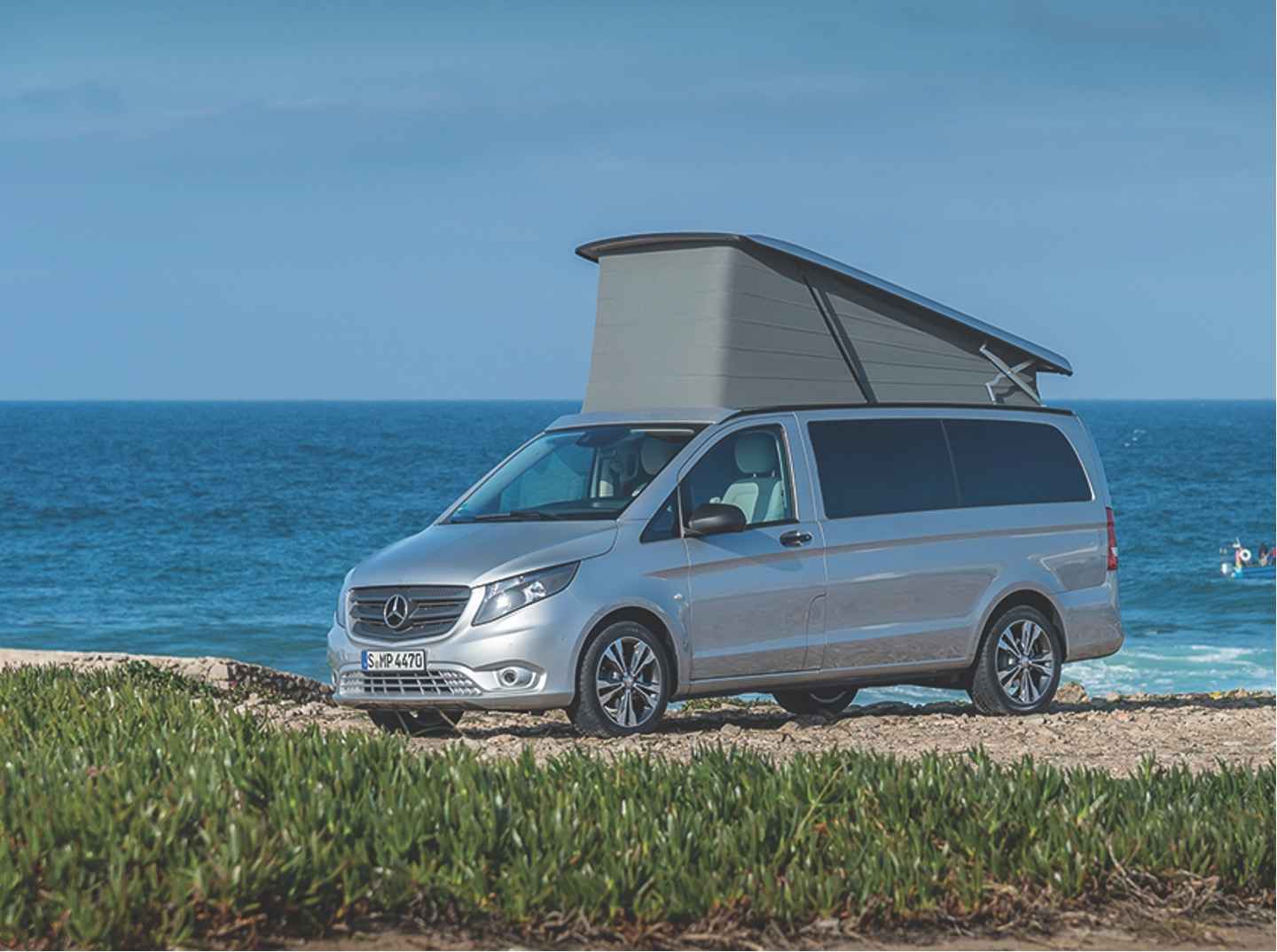
(Photo courtesy of Mercedes-Benz)
If you want both a daily driver and a weekend camper, a small pop-top camper is ideal. These are typically based on the VW Transporter and rivals such as the Ford Transit Custom, as well as a few on even smaller vans and some on imported Japanese vehicles, such as the Toyota Alphard.
All should feel car-like to drive and, with lengths around the same as an estate car or SUV, they are easy to park at the supermarket or in town. Some will fit into car parks with height restrictions.
Also known as a rising roof or elevating roof, the pop-top is usually raised manually (with assistance from gas struts), but there are electric versions, too. The pop-top is there primarily to provide standing room, but will often also offer a roof bed.
Remember, though, that with canvas sides to the roof, a pop-top is not ideal for midwinter trips. Most models have at least four belted travel seats, although some may offer five or six pews.
High-tops
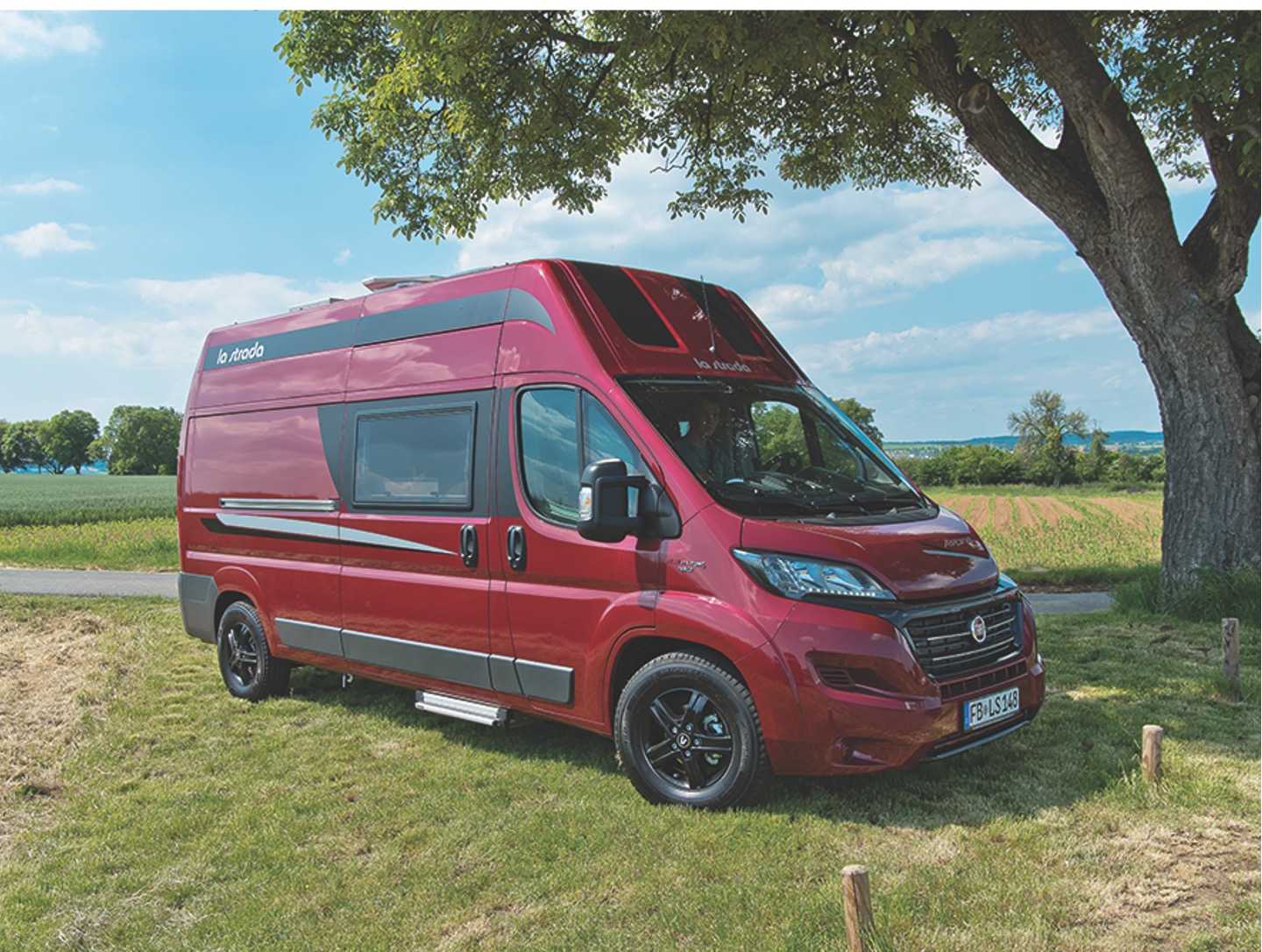
(Photo courtesy of La Strada)
If you want something a little bigger than a pop-top campervan, then high-top campervans have the advantage of usually offering full standing room all the time, a walk-in washroom and, possibly, a fixed bed.
The vans used here are taller and wider than the pop-top type (usually Fiat Ducato, Ford Transit, Mercedes Sprinter, Peugeot Boxer or VW Crafter), with lengths typically ranging from 5.4m up to 7m.
These campervans are, therefore, less practical for daily duties but are still more manoeuvrable (especially due to width and visibility) than a coachbuilt motorhome. They are also better suited to camping in the cooler months than a pop-top as they should be better insulated.
With more space comes a wider choice of layouts, but fewer family-friendly offerings. There are four-berth layouts with a matching number of belts, but these may fall into the next category – high-tops that also have a pop-top.
High-tops with pop-tops
Until recently this was a niche sector, but now there’s loads of choice, especially from continental makers. Here, standing room is already available without raising the roof (unlike in smaller VW models).
The pop-top is there purely to provide an additional double bed. Of course, the same comments apply about heat loss through canvas, but these vehicles are ideal for people who may only need four berths on some, not all, of their adventures. When used with the roof down they are all but identical to standard high-top vehicles.
Types of motorhome:
Low-profiles
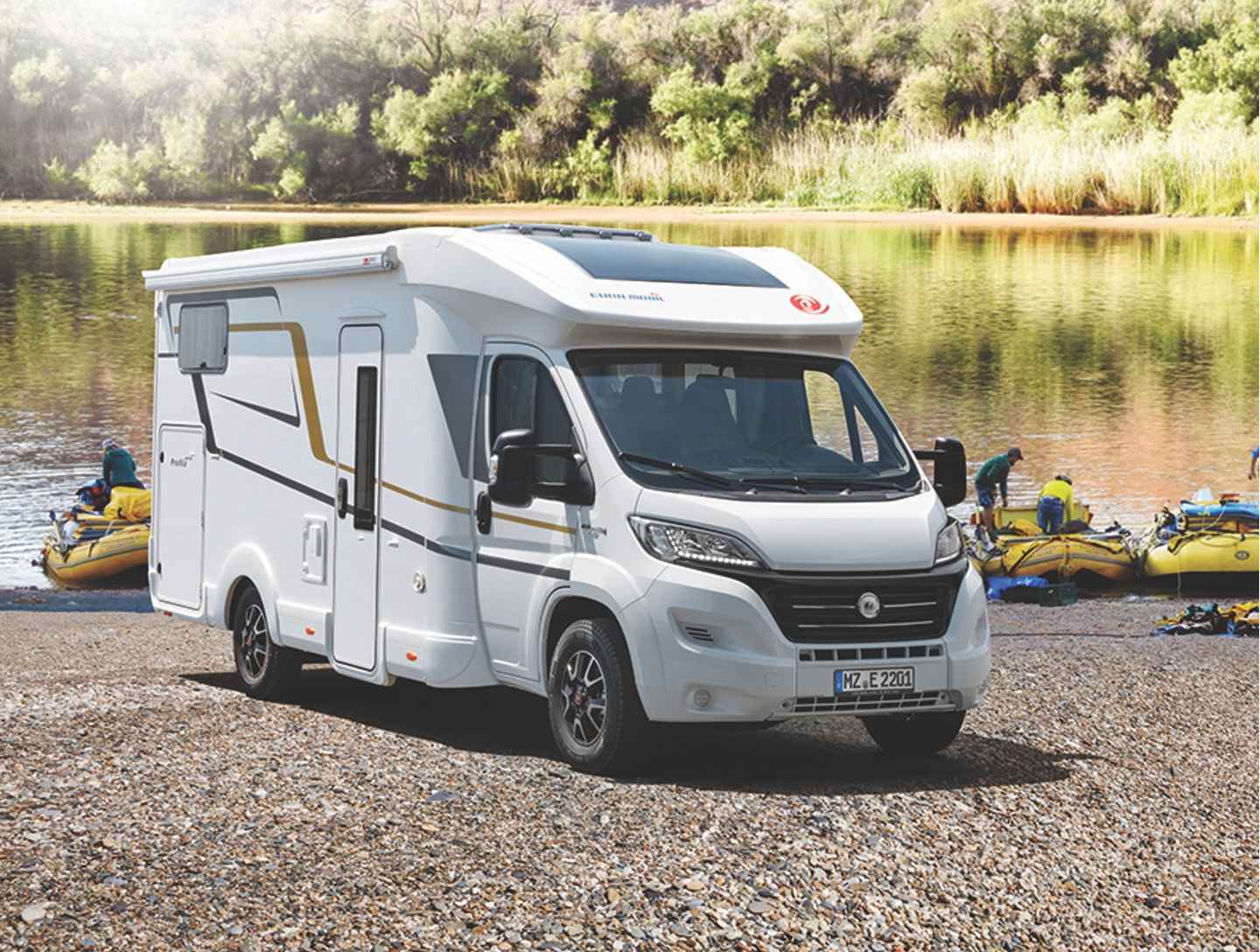
(Photo courtesy of Eura Mobil)
The difference between a low-profile and an overcab motorhome is at the front. The latter features a bulbous section that overhangs the windscreen (to provide a small bedroom), while the sleeker design of a low-profile can make it more aerodynamic (and more fuel-efficient).
Traditionally, low-profile models were more likely to be aimed at couples but the availability of drop-down beds over the lounge means that plenty of low-profiles cater for families.
Low-profiles vary in length from just under 6m up to 7.5m, with a few going up to 8m+. They are often built on a lowered chassis: Fiat’s own Camper chassis-cab or the Al-Ko alternative (on Fiat or Mercedes), with the lower centre of gravity paying dividends in on-road stability.
Overall widths of all coachbuilt types are usually around 2.30m to 2.35m, but there are some slimline low-profiles that aren’t much wider than a panel van and, therefore, suit more off-the-beaten-track destinations better.
Overcab coachbuilts
The obvious attraction of an overcab coachbuilt motorhome is the permanent double bed in the overcab, also known as the luton. While headroom can be tight for adults and ladder access might be off-putting, the luton makes great sleeping quarters for children. Unlike a drop-down bed in a low-profile, it leaves the lounge area undisturbed when it is in use.
Overcabs are popular with families and they often feature in entry-level motorhome ranges. However, with overall heights often stretching over 3m (resulting in costlier tolls on French autoroutes) and a less-than-aerodynamic shape, beware of underpowered vehicles.
If you’re looking at six-berth models, consider carefully the adequacy of the payload.
A-classes
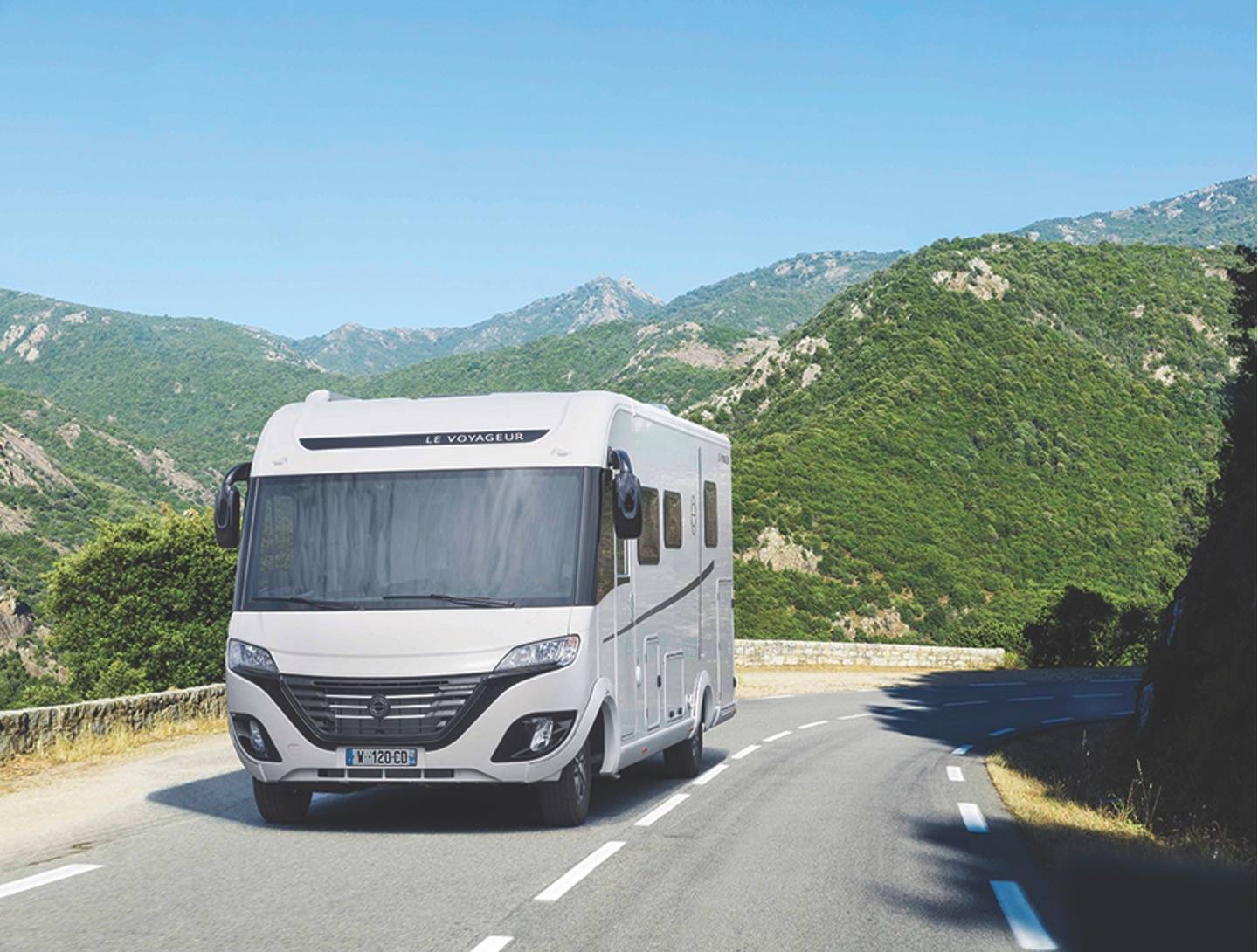
(Photo courtesy of Le Voyageur)
The top-of-the-tree in the motorhome world, A-class motorhomes start with a chassis-cowl, which has no external bodywork from the base vehicle – although the dashboard will usually still be familiar and the mechanicals (Fiat or Mercedes mostly) will be the same. All the exterior bodywork is created by the motorhome company.
The advantages are more space in the wider cab, usually a drop-down bed that lowers over the front seats (without interrupting the rest of the lounge), and fully insulated bodywork right up to the windscreen.
The advantages are more space in the wider cab, usually a drop-down bed that lowers over the front seats (without interrupting the rest of the lounge), and fully insulated bodywork right up to the windscreen.
Choosing the right size of campervan
If your campervan is to take the place of a car, size will be a major consideration. Will the campervan fit into parking bays or under height restrictions? A campervan can make a very versatile car, arguably much more useful than an SUV, but campers the size of a VW T6.1 or Ford Transit Custom are most likely to fit the bill.
Even if you’ll be driving your camper less frequently, you need to be comfortable and confident at the wheel. If it seems cumbersome or underpowered, this will spoil your enjoyment every time you go out.
That’s why it’s so important to take a test drive, to consider options like engine upgrades and automatic options, as well as hiring first to get the feel of driving a leisure vehicle. Some seating positions don’t suit shorter drivers, while others have seat adjustment that is too limited for taller folk.
Once you’ve adjusted the seat and steering wheel, look at visibility all around, and check whether a reversing camera is included.
Another consideration is the size and accessibility of your driveway – you might be able to keep your motorhome elsewhere (such as at a secure storage site), but then it’ll be a lot less convenient for spur-of-the-moment getaways. Most insurers are reluctant to cover motorhomes that are parked on the street.
Can I drive a motorhome with my car licence?
If you passed your car driving test on or after 1 January, 1997, you are limited to driving a vehicle of no more than 3,500kg maximum weight. This will include most campervans (except the largest models) and many motorhomes, even a few A-classes, although you will have to be sure that you have enough payload in any 3,500kg motorhome.
If you passed your test before 1 January, 1997, you can drive a vehicle up to 7,500kg (enough for 99% of motorhomes, but not the largest American RVs). On reaching 70, however, you will only be licensed to drive vehicles up to 3,500kg, unless you apply to the DVLA (and take regular medical checks). You can then retain your 7.5-tonne entitlement in three-year chunks.
Because more young people are driving motorhomes, and older folk are losing their 7,500kg entitlement, motorhome manufacturers are increasingly striving to offer vehicles with a 3,500kg maximum weight. However, coachbuilts of over 7m in length and even some large van conversions offer very limited payloads within this limit (sometimes under 300kg).
Add a few options and accessories and you’ll quickly exceed the payload – and be driving illegally.
For most motorhomes there can be a solution – as long as you have a (C1) licence to drive vehicles of over 3,500kg. Some models can be upgraded to heavier chassis at the time of ordering new to give you more payload, while others can be subsequently uprated. If you think you may need to go down this route, talk to a specialist.
Before buying a heavier motorhome, though, you may want to consider that, in Europe, vehicles with a GVW of more than 3,500kg are often subject to reduced speed limits and increased toll charges. They might also be barred from some roads in towns.
In the UK, car speed limits apply unless your vehicle’s unladen weight exceeds 3,050kg.
For more information, see our beginner's guide to motorhome weights and payloads.
Things to consider
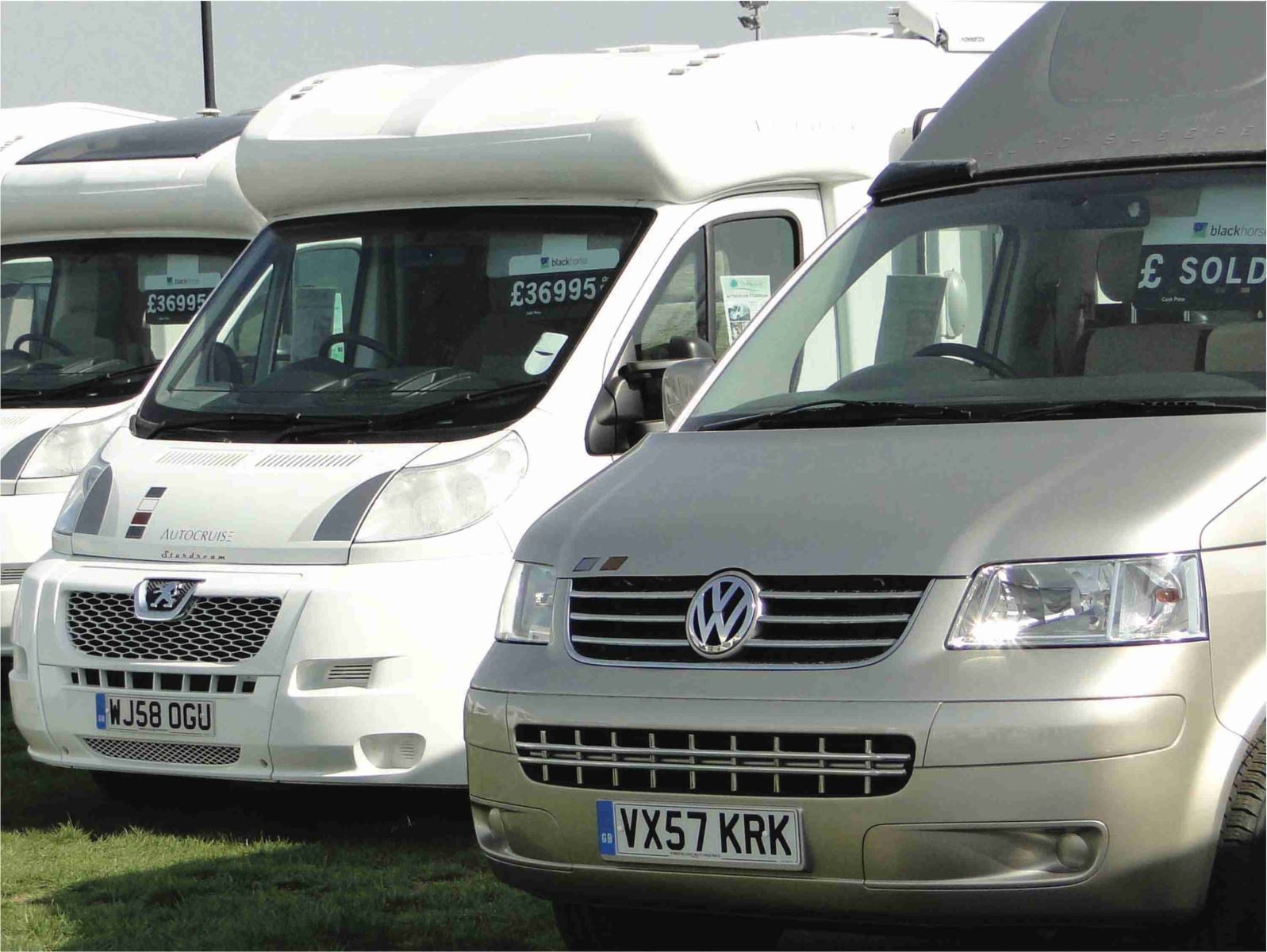
(Photo courtesy of Warners Group Publications)
On every trip in your motorhome, you’re likely to spend more time driving and sleeping than anything else, so these should be your top priorities. A mattress topper might improve sleeping comfort but, if the bed is too small or access (via a ladder or by climbing over your partner) is too difficult, then you won’t get enough kip – and absolutely nothing is more guaranteed to ruin your holiday than insufficient shut-eye.
In a similar vein, think about the space to get undressed and access to the loo, as well as whether you can sit up in bed.
You might be dreaming of hot summer days, sitting outside your campervan around the barbecue, but the reality is that the weather won’t always be wonderful.If you’re stuck inside the motorhome, what will you do? Will there be enough space, and will you be comfy? Often, the motorhome’s cab seats are the best place to relax, once you’ve swivelled them, so do they rotate easily and can you put your feet up once they’re facing the living area?
If you’ll be motorhoming with your family, will there be room for everyone, perhaps with separate TV and quiet zones, or different areas for kids and parents? Can everyone see the TV, or easily reach the table at mealtimes? Do you prefer a table that’s always in situ or a removable one; in which case, how easy/heavy is it to extract and erect?
Where are you planning to stay in your motorhome? There are some superb campsites with fabulous facilities (swimming pools, etc) – such as the Premier Parks network – but the cost of using top-quality campsites can mount up on a longer trip.
If you have a proper washroom in your motorhome, you may prefer to use small, basic campsites (such as the Certificated Sites – CSs – run by the Camping and Caravanning Club or the CLs operated by the Caravan and Motorhome Club), or aires on the Continent, or perhaps you’ll just want to park up off-grid anywhere that you’re legally allowed to.
In that case, you’ll need to be more self-sufficient, so a large fresh water tank (minimum 100 litres), a second leisure battery (or upgraded to lithium) and a solar panel become must-have features.
You might even want a spare cassette for the toilet if going off-grid for more than the odd couple of nights and, if you really want to explore right off the beaten track, then suitable off-road tyres or even four-wheel drive may be on your shopping list.
If your favourite destination is somewhere with narrow lanes, think about a campervan or a narrow-bodied coachbuilt. Then, when you get to a site, will you walk or cycle? Or will you want to explore in your campervan? Keeping it compact will help enormously with parking, especially in towns.
If you’ve retired and have all the time in the world for a grand European tour, it may be more important to ensure you have loads of storage and a payload to match.
Remember, too, that the Calor gas cylinders usually used in the UK are not replaceable/refillable abroad, so a larger fitted LPG gas tank or, perhaps better still, a diesel-fired boiler/heating system will be advantageous. Very little gas is used for cooking (in comparison to heating), so this becomes even more important in the cooler months of the year.
If you’re a foodie, you might be looking forward to cooking in your motorhome; in which case, preparation space will be as important as the facilities on offer.
Most models (apart from VW-sized campervans) can be specified with an oven, even if one is not standard, but microwaves are rare in imported models (and can usually only be used when you hook up to mains electricity, unless you have a powerful inverter and battery capacity to match). You may find an extra cupboard a lot more useful than an infrequently used microwave.
If you want to take bikes, will you need a garage, or are you happy to hang them on a rack on the back of the motorhome? Think about other bulky stuff you’ll want to carry – free-standing awnings for extra living space, kids’ toys, the barbecue and outdoor furniture.
And if you’re travelling mob-handed, is there sufficient space for everyone’s clothes – even four spare pairs of shoes or boots take up quite a lot of room!
Choosing the right layout in your campervan or motorhome, to suit all of the above, can be a complex process. You can read more about all the different types of layout here.
The best campervans and motorhomes to buy?
The best campervans and motorhomes to buy? If all of the above has whetted your appetite to buy a new campervan or motorhome, check out some of the best new models of 2024, as selected by our team.
Each year Outandaboutlive assesses the latest models and picks the best of the best in the Campervan Awards and Motorhome Awards, in association with leading consumer finance provider, Creation.
Expert motorhome advice to your door!
Why not subscribe to one of our fabulous magazines and get expert advice, travel ideas, technical help and all the latest news for your motorhome and your motorhome adventures!

Want to know more about MMM magazine?
Every month MMM has articles written by motorhomers who have been there and done it, from great UK and European (and further afield) tours, campsite reviews, owners' reports and DIY projects among other things.
MMM's tests, reviews and expert buying guides are not to be missed. MMM's technical advice is a must and includes everything from weekend jobs to longer-term DIY projects. And much more!
About MMM magazine
Want to know more about What Motorhome magazine?
Every issue of What Motorhome magazine provides essential buying advice for anyone looking to buy a new motorhome or campervan or upgrade their existing model. With a pedigree of over 30 years of offering the best motorhome and campervan buying advice, every issue of What Motorhome includes more new motorhome and campervan reviews than you will find in any other magazine.
About What Motorhome
Want to know more about Campervan magazine?
Campervan is the exciting monthly magazine that will give you all the inspiration you need to explore the world in your campervan. Every issue is packed with real-life campervanning experiences, inspiring travel ideas in the UK and further afield, the best campsites to stay on, campervan road tests and reviews of the latest models, and much more!
About Campervan magazine







Recent Updates
How to get to the South of France for less (without using tolls)
Motorhoming through France can get expensive if you stick to the toll motorways, so take a look at this toll-free route to the south of France ...
Motorhome fridges: here's what you need to know
Keep your cool when buying a new motorhome fridge with this comprehensive guide to motorhome refrigerators, ...
Campervan festivals: all you need to know
Get the lowdown on going to a festival with your campervan. We've got everything you need to know, from ...
Off-grid campervans: what you need to know
Ditching electric hook-up and wild camping in your campervan is a great, low-cost way to enjoy the outdoors ...
Where and how to sell my motorhome: the ultimate guide
Whatever your reason for selling, there are a number of steps to take to try to get the best price for your ...
Gas tanks or refillable cylinders: our guide to motorhome gas
From cooking dinner to the central heating, gas is an essential feature of motorhoming – here, we explore ...
Engine management lights: all you need to know
What is the engine management light? What does it mean, and what do I have to do? ...
Motorhome air suspension: all you need to know
Motorhomes are heavy and the additional weight of equipment and height of the bodywork can increase the loads ...
Motorhome WiFi: how to get better motorhome internet
Staying connected on the move is more and more essential, so relying on campsite WiFi isn't an option – here ...
A class of their own - our guide to A-class motorhomes
Thinking of trading up to an A-class, or even going straight to the top of the motorhome tree? We guide you ...
Other Articles
Explore overseas on a motorhome dream tour
Enjoy exotic travel in a campervan or motorhome by hiring, swapping with someone else or exporting your vehicle to another country – this is our ...
Motorhome water systems: everything you need to know
On-board water is an important part of every motorhome – here’s everything you need to know ...
Campervanning in Europe: what you need to know
Whether you're planning a leisurely drive through the French countryside, navigating bustling city streets in ...
Campervan security: all you need to know
With thefts on the increase, it’s important to know how to keep your campervan secure and prevent campervan ...
Campervan furniture: everything you need to know
Our campervan experts guide you through all the essentials for your campervan, including tables, chairs, ...
Campervan finance: how to fund your purchase
Here we look at the different types of campervan finance available, to help you decide what’s the best option ...
Britain’s best used motorhomes
Want a great motorhome without paying the premium for a new one? Here's a guide to the best you can get in ...
Campervan washroom essentials: stay fresh on the road
Our guide will take you through the campervan washroom essentials you'll need so you're well-prepared for ...
Dogs in campervans: all you need to know
Follow our advice and your dog will enjoy campervanning as much as you do ...
Electric campervans: all you need to know
Our guide will take you through everything you need to know about electric campervans and what the future ...